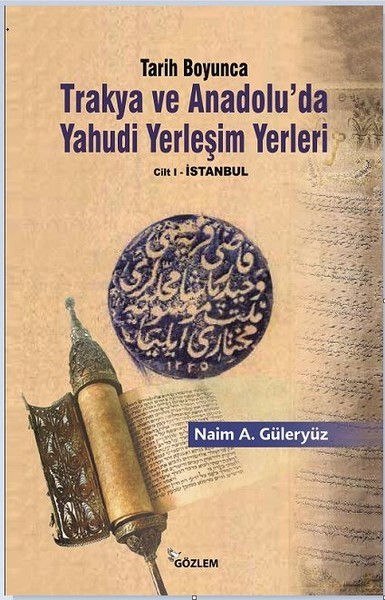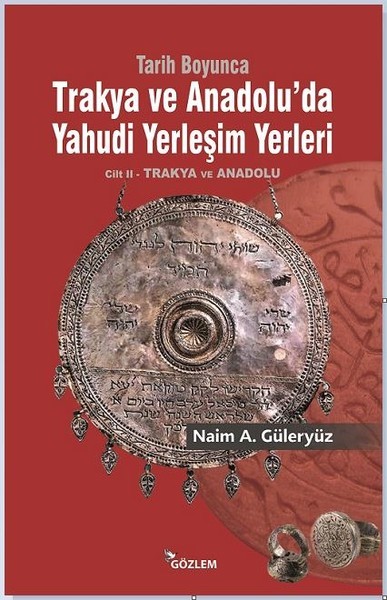Naim A. Güleryüz
TARİH BOYUNCA TRAKYA ve ANADOLU’DA YAHUDİ YERLEŞİM YERLERİ
(Areas of Jewish Settlement in Thrace and Anatolia throughout History)
Vol. I – Istanbul; Vol. II – Thrace and Anatolia
Gözlem Publisher, İstanbul, 2018, ISBN: 9786052061046
Reviewed by Bension Varon1
Naim Güleryüz, the eminent historian of Turkish Jewry, has given us, again, a truly magnum opus. The numbers speak for themselves: a text of 586 pages in two volumes, plus a whopping 178 illustrations, information drawn from 96 interviews (in person or in writing), and a bibliography of 260 items. The work fills a near-vacuum. Although the great scholar Abraham Galante (1873-1961) executed a similar work in the early 1900s, it was undertaken sporadically (in stages) and is a century old by now.2 Güleryüz’s opus updates and greatly expands Galante’s work and has the advantage of ‘unity of time,’ that is, all parts were drafted at about the same time, corresponding roughly to today. It also benefits from the technical revolution in communication, data storage and processing, the internet, and more. Another strength Güleryüz has and builds upon is his wide access to people, as evidenced by the nearly one hundred interviews he conducted.
The work reviewed here is about the geographic or spatial distribution of Jews in present-day Turkey. It is well established and documented — including by the author of the current work — that a large, perhaps the largest, number of the Jews expelled from Spain in 1492 settled in the lands controlled by the Ottoman Empire. They covered, in addition to Anatolia, also known as Asia Minor, parts of the Balkans, the Middle East, and North Africa. Güleryüz’s book is limited to the modern Turkish Republic established by Atatürk in 1923. It is drafted in contemporary Turkish. And it is intended in the first instance for the Jewish citizens of Turkey, their descendants, like myself, Turkish and non-Turkish scholars, and the non-Jewish population who lived and continues to live with the Jews in the land where they flourished for more than five centuries.
Volume I is devoted to greater Istanbul, one of the largest cities in the world in terms of space or acreage — a city larger than London — although recently one of the largest in population, too. Istanbul is a city spread over two continents and divided by the Golden Horn into the old Byzantine and, later, Ottoman city and the quintessentially cosmopolitan city that stretches from the inland Marmara Sea to the daunting Black Sea. The book covers seriatim the city’s more than 30 separate districts or neighborhoods, each with distinct histories and identities, where Jews were or may be found today. Volume II focuses entirely on the six major cities in Thrace — the small (3 percent) European side of Turkey — and the 50 largest cities in the rectangle-shaped Asiatic mainland of the country.
The unit of analysis is threefold: (i) places of worship, or synagogues, (ii) cemeteries, and (iii) schools, often with the addition of charitable institutions such as orphanages and hospitals. This is appropriate since religion and tradition, from birth to death, define Jews wherever they live. Güleryüz is eminently well suited to carry out this ambitious work, being a historian, teacher, author of 13 outstanding books, founder and former director of the Jewish Museum of Turkey, and multilingual.
The main objective of the book is to close or narrow the information gap on the settlement of Jews in Turkey, in other words, to provide the maximum information available on it. In so doing, the author hoped to stimulate and facilitate what he called in his introduction “faith [or cultural] tourism,” (Volume I, p. 14) as opposed to tourism chasing the sun and the sea. The book achieves this well. It is encyclopedic in coverage, although it would have benefitted from two things, one easy, the other much more difficult. The easy one would have been the addition of one or more maps, which would have facilitated the absorption and appreciation of the wealth of information presented — a minimal addition to the 178 illustrations already included. More difficult but useful would have been to include more quantitative information — numbers on the Jewish population of the various localities covered. Clearly, these were scarce and the author does cite the few that are available. However, even estimates of the Jewish and non-Jewish total population of the various places (available through national censuses) would have been useful by providing an indication of the size and possibly the economic attraction of the places to the Jews who settled there.
Given its focus on information, the book does not have a unifying theme or themes. It is, therefore, difficult to provide a synopsis of it. It has a number of strengths and gems, however. The detail provided is its greatest strength. Its coverage of the Jewish communities of greater Istanbul, past and present, is unprecedented even by the standards of someone like me who grew up in Istanbul. In Volume I devoted to it, as well as in Volume II, devoted to the rest of Turkey, the book covers localities where Jews lived historically, though no longer. This is of interest to descendants of the original settlers and, naturally, to researchers. Another notable strength of the book is its numerous illustrations, all in color no less, completely lacking in Galante’s earlier work.
Among the book’s gems, for this reviewer at least, are references to the customs and traditions long prevailing in the various localities. In Çanakkale, for example, according to one of Güleryüz’s interviewees, after the wedding, a bride crosses the threshold by jumping literally over a silver platter containing a fresh fish, while family and guests throw coins into it. The fish is then preserved with ice. It is cooked the following day, when the coins collected are distributed to needy people. Silly, perhaps, but not to Jews of Çanakkale and their descendants! The book contains many such anecdotes or useful diversions.
The organization and presentation of both volumes are geographical, a fact which reinforces their character and utility as reference works, which they mainly are. Volume II is organized by region, sub-region, city, and smaller urban areas. The reader, therefore, can easily look up his/her area of personal interest, usually where their ancestors originated from. The book, such a book, is not meant to be read from cover to cover.
But I am not a typical reader. My aim was to read the book more as history — collective history of Turkish Jews — than as a reference work. I found this difficult to do, partly because of its broad coverage. A more selective approach would have allowed treating in greater depth subjects or institutions such as: the non-Sephardic, Ashkenazic, and Karaite Jews of Turkey; the Romaniotes, who predated the arrival of the Spanish Jews; Istanbul’s historic Jewish hospital, Or Ahayim; its so-called Italian cemetery, and so forth. It is unfortunate that today’s very active Ottoman-Turkish Sephardic Cultural Research Center received only ten lines.
Reviewers often run the risk of seeming critical simultaneously of too little and too much information. This reviewer is no exception. I confess, however, that while appreciating the wealth of information on the distribution of Jews in Turkey, I missed explanations of what brought them to the various places where they lived spread like stars in the sky — places all over Asia Minor, from the Aegean coast in the west to near Mount Ararat in the East, from the Black Sea shore in the north to the Mediterranean shore in the south.
Furthermore, the key question today is not, or no longer, why Sephardic Jews came to Turkey and where they made their homes, but why their numbers have been dwindling at a rapid rate, as those of the Greek and Armenian populations. In the case of the Jews, abandoned places of worship have been maintained increasingly by visiting loyalists and benefactors on selected days. This has already been the case with Çanakkale’s only remaining synagogue and the restored historic synagogue of Edirne. What are the frightening prospects that the same may happen to the synagogues of Istanbul, Izmir, and Ankara some day?
The above observations are not intended as criticism of Güleryüz’s excellent work. No book can answer all questions. Güleryüz has addressed many of those I raised in his other works. His recent work needs to be seen in this context, that is, as a valuable scholarly addition to the history of Turkey’s Jews. It deserves translation, follow up, and a big thank you!
1 Bension (Ben) Varon is a retired economist, born and raised in Turkey, who has written frequently for Sephardic Horizons.
2 Galante’s collected works were published as Histoire des Juifs de Turquie (Istanbul: ISIS) in nine volumes in 1986 (25 years after his death). The individual works are, however, much older.
Copyright by Sephardic Horizons, all rights reserved. ISSN Number 2158-1800


